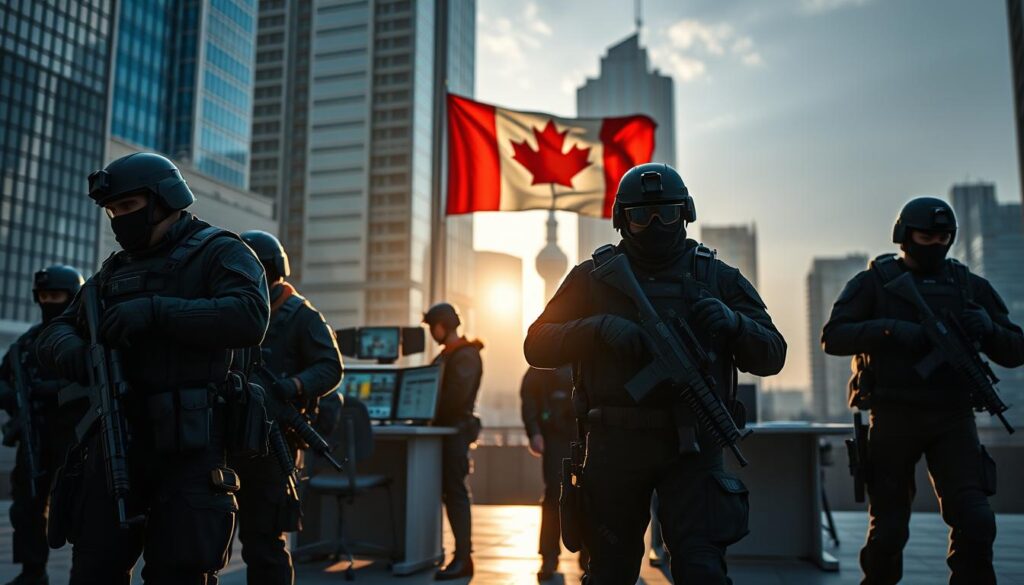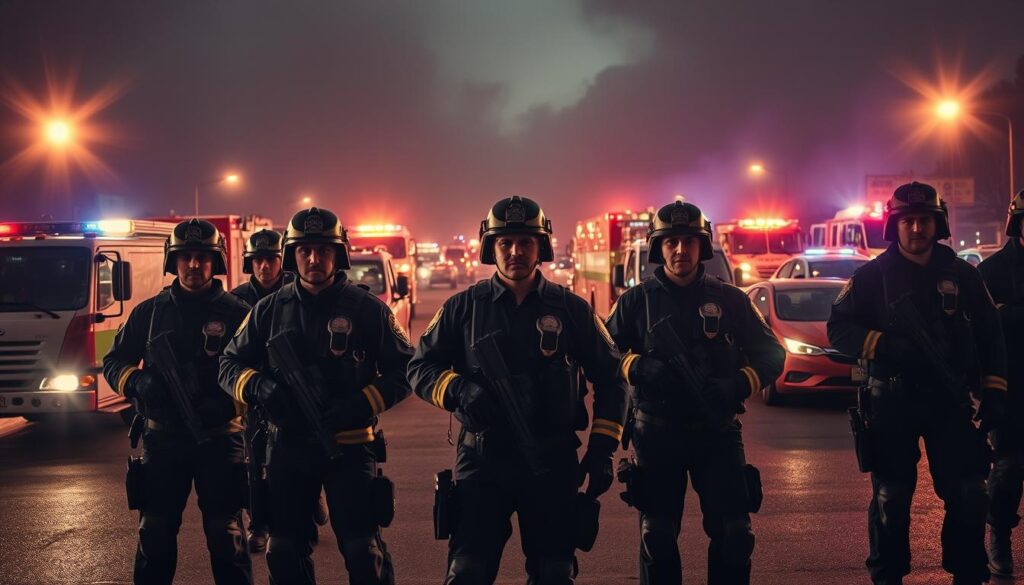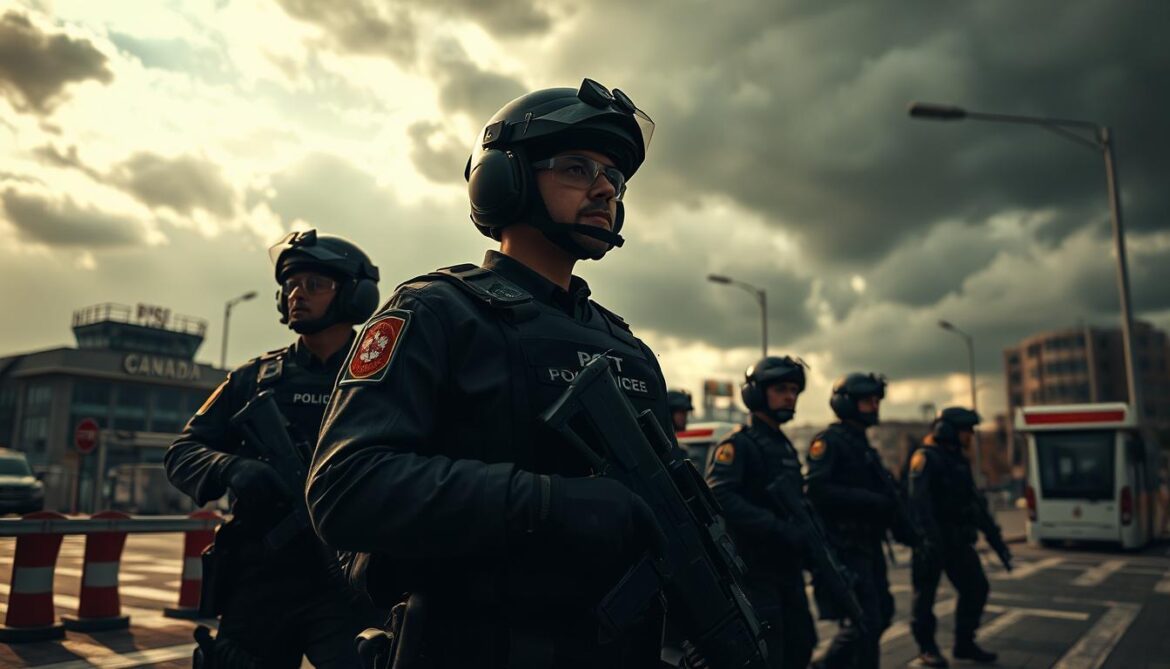Did you know 67% of Canadians see terrorism as a real concern today? This shows how important it is to stay alert and ready. Knowing and using smart ways to stop terrorism can really lower risks and make everyone safer.
Being aware and spotting anything odd is key to fighting terror. Adding anti-terror steps to your daily life can help keep our communities safe. We’ll look into important safety tips next. These tips help avoid and react to possible terrorist threats.
Understanding the Terrorist Threat in Canada
Canada faces complex terrorism challenges that stem from both inside and outside its borders. These threats change over time. Knowing the history, current dangers, and key sources of these threats is key to keeping the country safe.
The History of Terrorist Attacks in Canada
In Canada, terrorism has caused major events that changed government actions and how people see safety. For example, the bombing of Air India Flight 182 in 1985 is still one of the deadliest terrorist acts involving Canadians. The 2014 attacks on Parliament Hill also showed how important it is to protect national security.
Through the years, Canada has faced attacks from both global and local terrorists. This shows the ongoing need to stay alert and adaptable. Because of these attacks, Canada now has stronger security and counterterrorism plans.
https://www.youtube.com/watch?v=eF7_Jh0TgDU
Current Threat Levels
Evaluating Canada’s terrorist threat levels requires looking at politics, global situations, and intelligence findings. The Canadian Security Intelligence Service (CSIS) keeps track of these threats regularly. They ensure that both the public and security teams are updated.
At present, Canada’s threat level is at a medium. This means there is a real concern about possible terrorist acts. This level is based on constant review by national security teams. They consider both local incidents and global happenings that might affect safety in Canada.
Main Sources of Threats
Terrorist threats in Canada come from many places. This includes people radicalized in Canada, international terrorist groups, and lone individuals motivated by conflicts elsewhere. Extremist ideas can spread through the internet, making this a complex issue.
Understanding where these threats come from helps Canada better defend itself. It’s also crucial for everyone to be aware and cooperate with security forces. This teamwork is vital for keeping both the nation and its communities safe.
Identifying Suspicious Activity
In today’s world, staying safe is more important than ever. Knowing how to spot and react to threats is key. Everyone should learn to identify signs of danger. This helps keep our communities secure. By understanding what to look out for and how to report it, you play a part in preventing security issues.
Recognizing Unusual Behavior
Learning to spot suspicious behavior means watching for things that don’t seem right. When people look out of place or act strangely, it’s essential to notice. Behaviors like hanging around where they shouldn’t, showing too much interest in security, or carrying odd items need attention. Spotting these signs early can stop potential threats.

What to Do if You See Something Suspicious
If you notice anything suspicious, it’s important to act wisely. Here’s what to do:
- Stay away to ensure your safety and avoid any direct conflict.
- Write down key details like the exact time, place, and what you saw.
- Call the police or the right people to report what you’ve observed.
- Give clear, detailed information to help with their investigation.
This guide summarizes how to spot and report suspicious activities:
| Action | Steps |
|---|---|
| Recognizing Suspicious Behavior | Watch for anything unusual or out of place. |
| Documenting | Remember key details like time, place, and what happened. |
| Reporting | Alert the authorities right away. |
By being vigilant and quick to report, you can help keep everyone safe. Always trust your gut if something seems off.
Counterterrorism Strategies in Canada
Canada has rolled out detailed strategies to keep its people safe and secure the country. These strategies include government actions and the strong involvement of police forces.
Government Initiatives
The Canadian government uses a combined approach against terrorism. It relies on the Anti-terrorism Act and the Security of Canada Information Sharing Act. These actions are key to stopping threats early and sharing data between agencies. Also, the government invests in programs to stop the spread of radical views in communities.
The Role of Law Enforcement Agencies
In Canada, the fight against terrorism heavily depends on law enforcement. The Royal Canadian Mounted Police (RCMP) and the Canadian Security Intelligence Service (CSIS) are at the forefront. They focus on stopping terrorism by watching for dangers, collecting intelligence, and working with communities. Officers get regular training and practice drills to stay ready for any threat.

| Category | Description |
|---|---|
| Legislation | Anti-terrorism Act, Security of Canada Information Sharing Act |
| Agencies Involved | RCMP, CSIS |
| Focus Areas | Surveillance, Intelligence Gathering, Community Engagement |
| Programs | Counter-Extremism Programs, Inter-agency Collaboration |
Canada’s government and its law enforcement are key to keeping the nation safe. By always updating their strategies, Canada stands strong against terrorism threats.
Tips to Prevent Facilitating Terrorist Activity
Stopping terrorist activities begins with community awareness, safe online habits, and reporting radical behavior to authorities. These measures help create a secure atmosphere.
Community Awareness and Education
Efforts to prevent radicalization within communities are crucial in reducing terrorist threats. Organize educational events like workshops to teach the public how to recognize and resist extremism. Involve community leaders in sharing knowledge to keep everyone informed.

Protecting Your Online Presence
Safe online practices are key to avoiding terrorist exploitation. Use strong, different passwords and turn on two-factor authentication. Be careful with what personal info you post on the web. Always be critical of the sites and apps you use to protect your sensitive data.
Reporting Radicalized Behavior
Identifying and informing authorities about radicalized behavior can stop potential terrorist acts. If you see someone sharing extremist views or recruiting, report them to local law enforcement at once. Acting quickly can help prevent terrorist activities.
Implementing Security Protocols
It’s crucial to adopt thorough security measures for your and your family’s safety. By ensuring strong home security strategies, observing public safety rules, and following travel security advice, you can greatly improve your protection.
At Home
Starting with strong home security is key. Make sure to secure doors and windows with strong locks. A good home security system should include cameras and alarms.
Keep your place brightly lit at night. Trim bushes that could hide intruders. Regularly change your security codes and make sure everything works right.

In Public Places
Being cautious in public spaces is vital. Keep an eye on your surroundings and quickly report anything odd. Know where the emergency exits are in buildings and join in safety drills.
Avoid areas that are isolated and dimly lit. Try to stay in groups. Be cautious around unattended items and stay on your toes.
During Travel
Sticking to strict travel security rules is a must while traveling. Keep duplicate copies of key documents like your passport in several places. Use baggage locks and never leave luggage alone.
Be extra careful in busy spots like airports and stations. Keep up with the security situation at your destination. Inform the embassy or consulate about your travel plans for updates and help if needed.
Adopting these important security habits can strengthen your protection against threats. For deeper insight into staying safe, check out the resources by Public Safety Canada.
Preventing Radicalization
In today’s world, stopping extremism is key to keep your community safe. Through community interventions, we can reduce the risk of radical behavior. Early detection and support help at-risk individuals steer clear from dangerous ideologies.
Education plays a big role in fighting extremism. It teaches about the risks of radical views. By encouraging critical thinking, it helps people say no to harmful beliefs. Schools and community centers are great places for this learning.
Talking with community leaders is vital too. They know the culture and social patterns of their areas. They can spot warning signs early. Then, they can help those in danger find better paths with community interventions.

Table of Key Anti-Radicalization Strategies
| Strategy | Description | Benefits |
|---|---|---|
| Education Programs | Workshops and seminars on critical thinking and spotting extremist ideas. | Builds defenses against radicalization. |
| Community Engagement | Events and discussions that bring different people together. | Strengthens social bonds. |
| Support Networks | Creating groups for those showing early radicalization signs. | Gives people other options than extremist roads. |
Using these methods, your community can fight extremism well. Knowledgeable and involved communities are key to staying safe and secure.
How to React in an Emergency
Knowing how to act fast during a crisis can save lives. It’s key to know emergency techniques and the RUN HIDE TELL steps. Being able to talk well in these times helps keep everyone safe and organized.
Run, Hide, Tell
The RUN HIDE TELL method is vital in emergencies. Let’s break down what you should do:
- Run: Escape quickly if it’s safe. Bring others if they will come, but move on if they won’t. Aim for a safe place.
- Hide: If escape isn’t an option, hide out of sight. Lock doors, block entryways, darken the room, and silence your phone.
- Tell: When safe, call for help. Give all the details you can, like where you are and what you know about the danger.
Communicating During an Emergency
Talking right in a crisis is key. Make sure you and your family know how to keep in touch. Use texts or online messages if calls won’t go through. Have important numbers easy to find.
Plan where to meet if you get split up and how you’ll communicate. Tell the authorities early to get help and support the response.

Building Community Resilience
Developing strong community resilience strategies is crucial against emerging threats. Fostering close-knit communities and proactive initiatives helps lower terrorist activity risks.
Creating Strong Community Bonds
Strengthening community ties is key to boosting resilience. Through community events, local meetings, and collaborative projects, trust and cooperation among neighbors grow. A united community can better recognize and tackle potential threats.
The Importance of Neighborhood Watch Programs
Neighborhood watch programs play a vital role in enhancing security. They work through community members working together to watch and report anything suspicious. Setting up these programs boosts safety and strengthens bonds in the community.

| Strategy | Benefits | Example |
|---|---|---|
| Community Gatherings | Fosters relationships and trust | Annual neighborhood barbeque |
| Neighborhood Watch Programs | Enhances vigilance and safety | Weekly surveillance schedules |
| Local Meetings | Promotes awareness and communication | Monthly town hall discussions |
Staying Safe at Large Events
It’s very important to stay safe at big events, like music shows or sports games. You should take steps to protect yourself in crowds. This makes sure you can have fun without worrying.

Tips for Concerts and Festivals
Concerts and festivals bring lots of people together. To stay safe at these big events, here are some tips:
- Arrive early to learn the place and find emergency exits.
- Avoid big bags or items that are hard to carry in an emergency.
- Stay in bright, busy areas and go with friends to be safer.
- Keep an eye on what’s happening around you and tell authorities if you see something suspicious.
For more tips on staying safe in public places, check out Canada Crime Report.
Safety Measures at Sporting Events
Sporting events are full of fun but also very crowded. To stay safe, follow these safety tips:
- Learn where you can get in and out of the stadium for safe evacuation.
- Drink plenty of water and dress comfy to avoid problems in big crowds.
- Keep your valuables close to avoid theft.
- If you’re with kids, pick a place to meet if you get separated.
Safety measures at public events help make sure you have a good time. Following these tips can make your visit safer and more fun.
Using community resources and support makes these strategies work better. To get more information on staying safe at big events, explore Canada Crime Report. They offer helpful advice and tools for your safety at large gatherings.
Emergency Preparedness Planning
Being ready for emergencies can really help during a crisis. It’s key to have a detailed plan. Your family should also know this plan well. Here are important steps for making an emergency kit and a family escape plan.
Creating an Emergency Kit
An emergency kit is vital for getting through surprise situations. It needs to have things that keep you safe and comfortable. Below is a list of items your emergency kits should have:
- Water (one gallon per person, per day for at least three days)
- Non-perishable food supply for at least three days
- Battery-powered or hand-crank radio
- Flashlight with extra batteries
- First aid kit
- Whistle to signal for help
- Moist towelettes, garbage bags, and plastic ties for personal sanitation
- Dust masks to help filter contaminated air
Government Resources and Support
The Canadian government gives out many terrorism prevention resources and governmental support programs. These are important to keep people informed and safe. They help individuals and communities be ready for any threats.
Key Websites and Contacts
There are several important websites and contacts for help with terrorism prevention. They include:
- Public Safety Canada: They share lots of information on national security and emergency management. They’re a go-to for anti-terrorism training and other learning tools.
- Canadian Security Intelligence Service (CSIS): CSIS gives intelligence on possible threats to the country. You can report any suspicious actions through their website.
- Royal Canadian Mounted Police (RCMP): The RCMP’s website helps in recognizing and reporting terrorist acts. They also provide ways to contact local officers.

Available Training Programs
The government offers several anti-terrorism training programs. They target various groups like public safety officers, community leaders, and everyone else. These governmental support programs include:
- Operation Safeguard: This is aimed at boosting security awareness in businesses and among citizens. It includes workshops and training modules.
- National Security Community Outreach: These efforts help law enforcement work together with communities. They share useful practices and preventative steps.
- Community Resilience Training: These sessions help communities strengthen against radicalization and violence.
By using these terrorism prevention resources, Canadians help make their nation more secure.
Conclusion
To keep terrorism at bay, a mix of efforts is needed. This includes work by the government, community action, and being alert ourselves. Given Canada’s history and risk levels, it’s vital to spot and act on any suspect activities. This includes strict safety measures at home, in public spaces, and while traveling. By taking part in spotting and reporting odd behaviors, you play a big role in keeping your community safe.
Upping safety steps at big events and in daily life helps keep society ready and strong. Building a supportive community through strong ties and neighborhood watch helps fight off threats. It’s also key to have a plan for emergencies, make emergency kits, and plan how your family would leave in a crisis. Every home needs to do these things to be safe.
Being part of the community’s security is very important. Stay up-to-date by using government resources and help, join training if you can, and keep your online life safe. We must always be watchful, keep learning, and commit to safety actions. This helps keep our living areas secure for everyone. By pulling together, we can stop terrorist acts and make Canada safer for all.

